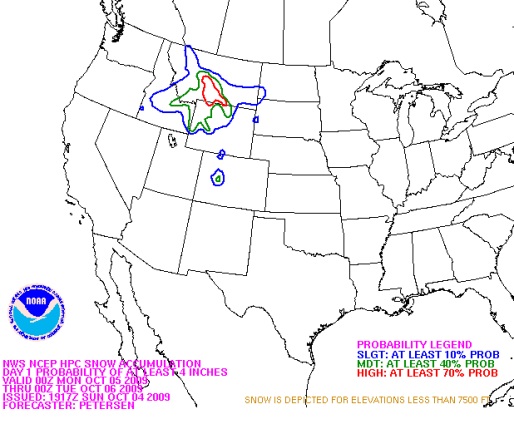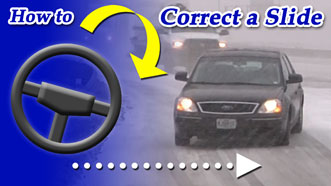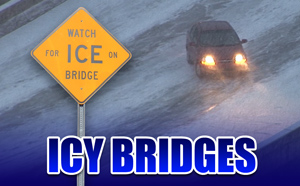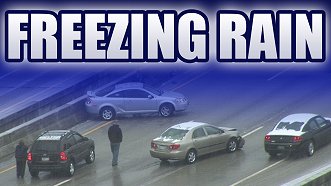Icy Roads: News and Updates Blog
October 2009 Archives
Big snowstorms usually low-risk icy road events
A major snowstorm has just tracked from the central Rockies across the Plains to Minnesota this week, dumping over 2 feet of snow in parts of Colorado. And yet we've not seen major accident reports coming in from this event - in fact, not a single verifiable report of an icy road fatality accident has come through from these regions. A fluke? Hardly - this is actually typical for a major snow event. Snowstorms are no strangers to icy road accidents, so why are the serious accident and fatality rates lower?
When a major snowstorm hits, communities are typically highly aware and prepared for the event prior to its impacts. Schools and workplaces close. Highways officials close many of the high-speed roads, including the interstates, that are the usual spots for fatal icy road accidents. When the storm is in progress, the sheer amount of snow prevents vehicles from easily reaching the speeds that are often associated with fatal accidents. Most accidents in snowstorms happen at the onset of the storm or on its fringes, where accumulations are lower.

1993 snowstorm in Washington, PA
Snow accounts for the most icy road fatalities during the winter, but it is the minor events - from a dusting to a couple of inches of accumulation - that cause the most serious snow-related accident outbreaks. That little dusting at morning rush hour - the one that never makes the news until after it's caused chaos - are the ones to watch out for. With minor snowfalls, people tend to be in 'business as usual' mode, not as aware of the hazards as they'd be for a big storm.
So, the key here is speed. Most fatal icy road accidents involve cars traveling highway speeds, usually above 45mph. During a big snowstorm, most drivers simply don't get their cars going that fast. During that little dusting of snow in the morning rush hour, drivers don't see the snow as much of a the hazard, and don't adjust their speed as a result. And consequently, the accident rates reflect this.
So, to summarize, I would classify major snowstorms as one of the lowest-risk forms of icy road events. It's the smaller, 'sneakier' events that cause the most problems - the light overnight/morning snow and the light freezing rain event are the most insidious and dangerous weather events that people regularly face in this country.
Icy bridge examples from WV this weekend
Bridges above 2,500 feet in the West Virginia mountains became coated with snow as temperatures reached the 32°F (0°C) mark on Saturday night. Here are some images from two good examples of the icy bridge phenomenon. Notice how the road conditions instantly change from just wet to slick snow and ice. Snow is easier for oncoming motorists to visually identify, but can still take unaware drivers by surprise. If snow is falling, expect any bridge on your route to be like this!

click to enlarge

click to enlarge
If this were a freezing rain event, there would be no visual identifier for drivers to see that ice was present on the bridges - a good reason to be aware of weather conditions and the possibility of icing whenever you get into your vehicle during the winter season.
Icy road season arriving in the Appalachians, US Northeast
The first snowfalls of the season are on course to begin within the next 24 hours across the northern Appalachain mountains and the northeastern US states. The Alleghenies of Pennsylvania into the interior New England regions are at risk of icy bridges and roads, particularly in the higher elevations. As the weekend progresses, the snow and cold temperatures should spread southward into the mountains of Maryland, West Virginia, and possibly as far south as the highest elevations in Virginia and North Carolina.
Help save a life this winter! Pass this site on to your friends and family. Join our Facebook and Twitter feeds by following the links at the top of this page.
No seatbelts in all fatal icy road crashes so far
Seat belt usage is one of the factors I'm tracking in this year's icy road fatality stats. Since Friday, all four of the in-vehicle icy road crash deaths in the US were rollovers where people not wearing a seatbelt were ejected. Although the season has just begun, this is a remarkably high ratio compared to last year. Nonetheless, seatbelt usage is a major known factor in the icy road hazard - as many as half, possibly more, of all fatalities last year involved drivers and/or passengers not wearing seat belts. Most of these deaths involved rollovers that may have been survivable if the occupants had taken the simple precaution of buckling up.
There are many people that choose to not wear seatbelts in everyday driving for one reason or another. If you fit into that demographic (or know someone who does), please buckle up at least when icy road conditions threaten, a time when your chances of having an accident are extremely elevated. If everyone in the country did that, it could cut the US icy road toll in half - maybe more.
In fact, the seatbelt issue is so prominent that it may become the number 1 icy road safety tip on this site.
Icy bridges responsible for most early-season wrecks
The vast majority of the icy road accidents in the past few days - now numbering in the thousands - have been caused by iced-over bridges and overpasses. The ground in most areas is still warm, and will take some time to cool before all-road icing becomes the norm. Learn more about icy bridges on our icy bridge page.
Help save a life this winter! Pass this site on to your friends and family. Join our Facebook and Twitter feeds by following the links at the top of this page.
At least two freezing drizzle deaths in Colorado
Freezing drizzle has resulted in at least two deaths in Colorado during the past 18 hours, quickly bringing the nationwide icy road toll to 3.
NEWS LINK: 1 Killed, 5 Injured In Colo. Springs Accidents
NEWS LINK: Fatal accident near Trinidad
As we get farther into winter, the fatal accident counts will begin coming in faster and more frequently - a grim reminder of the reason this site exists. As a result, I won't continue updating the blog here with each accident report - only the larger and more serious outbreaks will be covered here. The Twitter feed will contain more up-to-date information on accident reports. You can also keep up with the stats page to monitor the progression of the severity of this winter's icy road season.
Help save a life this winter! Pass this site on to your friends and family. Join our Facebook and Twitter feeds by following the links at the top of this page.
'Secondary crash' results in first US icy road death
A secondary crash - a 'follow-up' accident where a second vehicle loses control and crashes into someone standing outside of an earlier accident, has caused the first icy road death in the US this season in Minnesota:
NEWS LINK: Person hit and killed after getting out of a car after a crash
NEWS LINK: Crash victim hit on I-35W
These type of incidents are why it's important to stay in your vehicle after a crash - there will be other vehicles encountering the same icy spot that caused you to crash.
Meanwhile, freezing drizzle is responsible for numerous pileups on bridges in Colorado:
NEWS LINK: I-25 reopened after massive pileup
NEWS LINK: Metro Area Wakes Up To Icy Roads, Multicar Crashes
Help save a life this winter! Pass this site on to your friends and family. Join our Facebook and Twitter feeds by following the links at the top of this page.
Colorado road icing - no warning
Here is a good example of what I've been talking about for the past year now - how life-threatening light freezing rain can occur without reaching criteria that would trigger an official National Weather Service warning product. Light freezing rain is currently in progress in the Plains of northeastern Colorado, and is potentially icing bridges on Interstates 80 and 70 right now:

Observations at 8:00AM MDT Thursday
There is no official warning product or statement in effect for this hazard. Though events of this type may never trigger a Freezing Rain Advisory (or Ice Storm Warning), they still have the potential to cause serious accidents resulting in death and injury. Hopefully this one happening now in Colorado does not result in an accident outbreak - I will check reports later and upate this post.
Freezing rain and freezing drizzle are the worst type of winter precipitation - accident and fatality rates per mile driven are the highest of any other precip type. This is because road ice caused by freezing droplets is not visually apparent to drivers, meaning drivers encounter this type of ice before having a chance to adjust their speed. Crashes occur at higher speeds, with greater impact forces and resulting injuries/deaths.
You can read a longer article detailing this issue.
Help save a life this winter! Pass this site on to your friends and family. Join our Facebook and Twitter feeds by following the links at the top of this page.
Major icy road threat across the USA this week
Winter may be making its first widespread appearance in the USA starting on Friday. A winter storm system is forecast to develop in the Plains and move across the northern parts of the country into early next week. This storm could bring snow and icy roads to a broad swath from the Plains, through the Midwest, and into the Northeast.
MODEL GRAPHIC: GFS snow totals through Monday
MODEL GRAPHIC: NAM snow totals through Saturday
While the GFS model may be overdoing the snow totals, I believe that snow, freezing temperatures and icy roads are likely across a wide area through next week. The storm begins Friday and Saturday, affecting the mountains and high Plains of Colorado, Wyoming and Montana and the central Plains region including Nebraska, South Dakota, Kansas and the Oklahoma/Texas panhandles. The snow and freezing temperatures then move into the Midwest, affecting Minnesota, Wisconsin, Iowa, Missouri, Illinois and Michigan. By Monday and Tuesday, the storm moves into the northern Appalachians, threatening Pennsylvania, New York and the New England states. The Appalachian mountain regions could see snow as far south as North Carolina.
I will be tracking this system and posting running updates as it develops and moves across the country. An on-location 'winter storm' chase is also possible.
Subscribe to the icyroadsafety.com Twitter Feed for frequent updates and links to news articles throughout the winter.
Help save a life this winter! Pass this site on to your friends and family. Join our Facebook and Twitter feeds by following the links at the top of this page.
Icy roads could threaten large part of middle/northern US this week
Forecast models suggest that snow, ice and subfreezing temperatures could impact a large portion of the northern half of the United States during the upcoming week. Areas affected include Wyoming, Montana and the Dakotas in the northern Plains region, Kansas and Nebraska in the central Plains, and Iowa, Minnesota, Wisconsin and Michigan in the upper Midwest. Toward the beginning of next week, parts of the Appalachians and New England could see light snows and icy roads, particularly in the higher elevations of the mountain areas.
NEWS LINK: Icy bridge causes rollover in Billings, MT today
Subscribe to the icyroadsafety.com Twitter Feed for frequent updates and links to news articles throughout the winter.
Help save a life this winter! Pass this site on to your friends and family. Join our Facebook and Twitter feeds by following the links at the top of this page.
Icy roads cause accidents on I-80 in Utah today
NEWS LINK: Tractor trailer crash one of several in Parleys Canyon, Utah
Subscribe to the icyroadsafety.com Twitter Feed for frequent updates and links to news articles throughout the winter.
Help save a life this winter! Pass this site on to your friends and family. Join our Facebook and Twitter feeds by following the links at the top of this page.
First significant US snowstorm under way
Help save a life this winter! Pass this site on to your friends and family. Join our Facebook and Twitter feeds by following the links at the top of this page.
The first major US snowstorm of the season is in progress in the northern Rockies and the northern high Plains. Idaho, Montana, Wyoming, Colorado, Utah, South and North Dakota, and parts of Nebraska are at risk for road ice during the next few days. Heavy snow and accumulations of up to 2 feet are possible in some areas.

HPC snow outlook through midday Monday
First accident reports of the season
The first newsmaking icy road crash reports are already coming out of the intermountain West region:
NEWS LINK: Snowstorm catches motorists off guard
2009-2010 icy road season arrives
The arrival of October brings the annual return of the road ice hazard to the United States. The first major icy road event sequence of the season is about to begin in the intermountain West, Rockies and far western High Plains. While mainly a high-elevation event (above 5,000 feet ASL), many of the region's major thoroughfares and interstates will be affected. If you are traveling through these regions, be aware of the conditions - they will likely change rapidly from mile to mile! Icy road fatalities have already been reported in Canada as of this week.

HPC snow outlook for the next 24 hours
The return of icy road season means it's back to work bringing the icyroadsafety.com site back into active status. The statistics page has been reset for incident data collection during the 2009-2010 season. Added to this year's stats will be seat belt usage and icing type data to better track some of the specific details in serious ice-related accidents.
With the winter weather season arriving, I urge you to give the road ice hazard its due attention. Keep a watch on the weather, and adjust your driving habits when road ice threatens. Stay tuned to the icyroadsafety.com site for up-to-date statistics, photos, video and other developments.
Recent Blog Posts
- Developing a road impact parameter for forecast models and mesoanalysis - October 29, 2021
- The deadly Fort Worth, Texas pileup of February 11, 2021: Its cause, contributing factors and future prevention - March 31, 2021
- Major road icing event affects 41 states - January 14-18, 2018 - January 20, 2018
- Trip to Mississippi and Alabama for Southern US winter storm - January 5-7, 2017 - January 22, 2017
- High-impact freezing rain/drizzle road icing event from Oklahoma to the East Coast - December 20, 2016
- New educational winter driving videos released, more planned - November 21, 2016
- "Icezilla" freezing rain disaster in the northeast US - January 19, 2015
- December 30-January 2 Oklahoma/Texas icing event sequence - January 2, 2015
- Freezing rain disaster - November 22, 2014 - November 23, 2014
- Report: Major winter storm in the Deep South, 1/28 - January 30, 2014
- Report: High Risk road icing event in south Texas/Louisiana - January 26, 2014
- Winter tires: not the solution for preventing icy crashes - December 13, 2013
- Preliminary low estimate of December 3-8 toll - December 9, 2013
- The Top 7 Icy Road Myths - December 6, 2013
- Aren't icy road crashes caused by driving too fast for conditions, not ice and snow? - November 14, 2012
- Road icing news for January-February 2012 - February 25, 2012
- Commentary on the recent viral WV pileup video - January 8, 2012
- Significant road icing outbreak: Monday, January 2, 2012 - January 2, 2012
- No vehicle can safely go highway speeds on icy roads - December 23, 2011
- Another case for "Road Ice Warnings": December 8-9, 2011 light snow event - December 10, 2011
- A big thanks to those helping raise road icing awareness - November 18, 2011
- 15 road icing deaths in the past week: estimating the full impact - November 4, 2011
- 2011-2012 road ice season in the US already in full swing - October 22, 2011
- Coming this winter: another 2011 tornado season toll - July 21, 2011
Past Blog Archives
- April 2010 - January 2011 posts
- December 2009 - March 2010 posts
- November 2009 posts
- October 2009 posts
- March-April 2009 posts
- February 2009 posts
- January 2009 posts
- December 2008 posts
Educational Winter Driving Videos - Watch for Free:
  
Home | Risk | Stats | Accident Video | Icy Bridges | Tips | Warning Signs | If You Slide | If You Wreck
1,836
Average annual
deaths in the US
from icy roads
136,309
Average annual
injuries in the US
from icy roads
[ More Statistics ]
|
|

